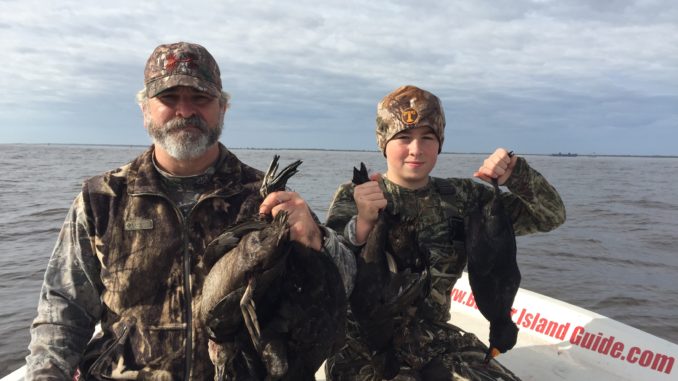
Don’t miss a chance to add to your waterfowling experience. Head off the beach for a limit of unpressured sea ducks.
Most South Carolina waterfowl hunters cut their teeth chasing wood ducks in century-old cypress sloughs or maybe a gaggle of greenheads in acres of flooded grain, but available duck-hunting opportunities are now in high demand. Lease fees and land prices continue to rise, and premiere waterfowl grounds under public control are steadily becoming overcrowded.
Luckily, there is another option for fantastic waterfowling along South Carolina’s coast, and the prime waters around Georgetown are available without the competition.
Sea ducks!
Sea ducks are a group of migratory species that skirt the beaches along the Atlantic seaboard to eat on the plentiful resources of mollusks, crustaceans, and even some small fish. According to Dean Harrigal, waterfowl biologist for the S.C. Department of Natural Resources, scoters are the primary sea duck species that winter along South Carolina’s coastlines.
“Our most-common sea ducks are surf scoters, black scoters, and white wing scoters,” Harrigal said, “but we will get old squaw and a few other species of sea ducks if we get a prolonged period of cold weather to drive them further south along their migratory path.”
While sea ducks don’t mingle with dabbling ducks and other ducks in freshwater and brackish environments, they typically migrate concurrently with other species’ movements over the fall season. As soon as hunters see ducks arriving inland, they can count on sea ducks showing up along the coast.
Hunters can also look for January’s cold blasts to contribute to growing numbers of sea ducks along the beachfront. Brief periods of arctic weather will drive them south, making Georgetown’s waters fill up, and specifically off North Island and around the Winyah Bay jetties.
Even though they could easily travel across the barrier islands and feed on the abundant inshore resources, sea ducks rarely cross over into estuarine environments, and it is uncommon for puddle ducks and divers to visit ocean waters to feed.
Steve Roff of Barrier Island Guide Service in Pawleys Island targets sea ducks as soon as they arrive, but it’s not just sea ducks that show up in his decoy spread during the late season, which ends Jan. 29.
“We frequently get buffleheads, mergansers and ruddy ducks when we are in the ocean,” said Roff (843-446-7337). “We will get an occasional stray diving duck like ring-necks and bluebills, but it is usually just scoters that make up our bag limit.”
While a six-bird limit of scoters, mergansers and ruddy ducks may not boast the vibrant colors of redheads, mallards and pintails, the wing-shooting can be exhilarating — without competition from other hunters. Sea ducks are limited to the areas immediately along the beachfront, and with the exception of a few winter anglers, the coast is almost void of people, which makes for endless shooting opportunities. But where exactly do hunters go to find the best sea duck action?
Sea ducks are capable of descending to depths of more than 100 feet to feed, but according to Harrigal, most frequent the region from the beachfront out several miles.
Roff targets sea ducks near the shore and in places where he can avoid heavy sea conditions.
“We stay relatively close to shore when we can; that is usually just beyond the breakers out to two miles,” Roff said. “Depending on how rough the ocean is will determine where we find the best flights. They will fly further offshore when the ocean is flat and then hug the beach when it’s rough.”
For hunters accustomed to hunting large lakes and sounds, the strategy can be similar. Sea ducks often travel in large groups, right off the surface, to avoid aerial predation. Their flight patterns traditionally pass near natural and man-made landforms that hunters can take advantage of to get flocks in range.
“It is similar to hunting around sandbars and grassy points. They are not big on flying over land features but will bounce off these areas that make for perfect ambush places,” Roff said.
The ends of jetties are one of the best places to hunt sea ducks. These rock piles create a bounce point to concentrate birds, And they give hunters something to associate with so their boats don’t look out of place with little available cover in between ocean waves.
Luckily, sea ducks are not accustomed to the same hunting as more-traditional waterfowl species, and cover and camouflage are not critical. Roff doesn’t use much concealment.
“One thing about sea ducks that is nice? You don’t have to do everything perfect. You need to break up the boat some, but full camo is not required,” he said.
Along the same lines, specialized decoys are not required. Roff uses a couple long strings of black and white decoys. Standard ring-neck, bufflehead or bluebill decoys are the closest match to the mostly black scoter species.
“Some hunters have had great success with using spray painted milk jugs,” he said. “You really don’t need anything special, but decoys definitely help though,” Roff said.
Roff usually uses two to three decoy strings. He will anchor a string of 25 off the bow and then tie another string of 25 off the stern.
Sea ducks typically trade off across the water in long flight lines. A flock of 75 might not always come into shotgun range, and hunters need to engage when birds are in range if whirling into the decoys or just passing by.
“The larger flocks don’t come to small spreads much, but they will come off their line, and you can get some good pass shooting,” Roff said. “If you get small groups of three to four birds, they will usually decoy well.”
Roff relies on No. 2 steel shot.
“The shot opportunities are rarely any more than 20 feet off the water, but they are moving fast. If you take the extra second to lead them and follow through your shot, you will knock down plenty of them,” he said.

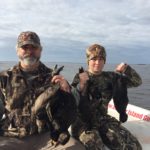
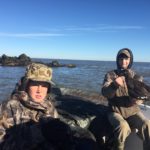
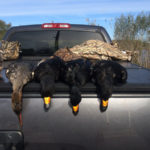
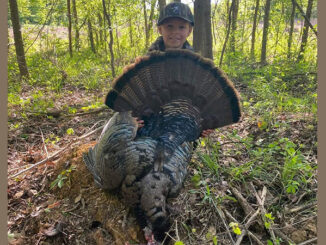

Be the first to comment